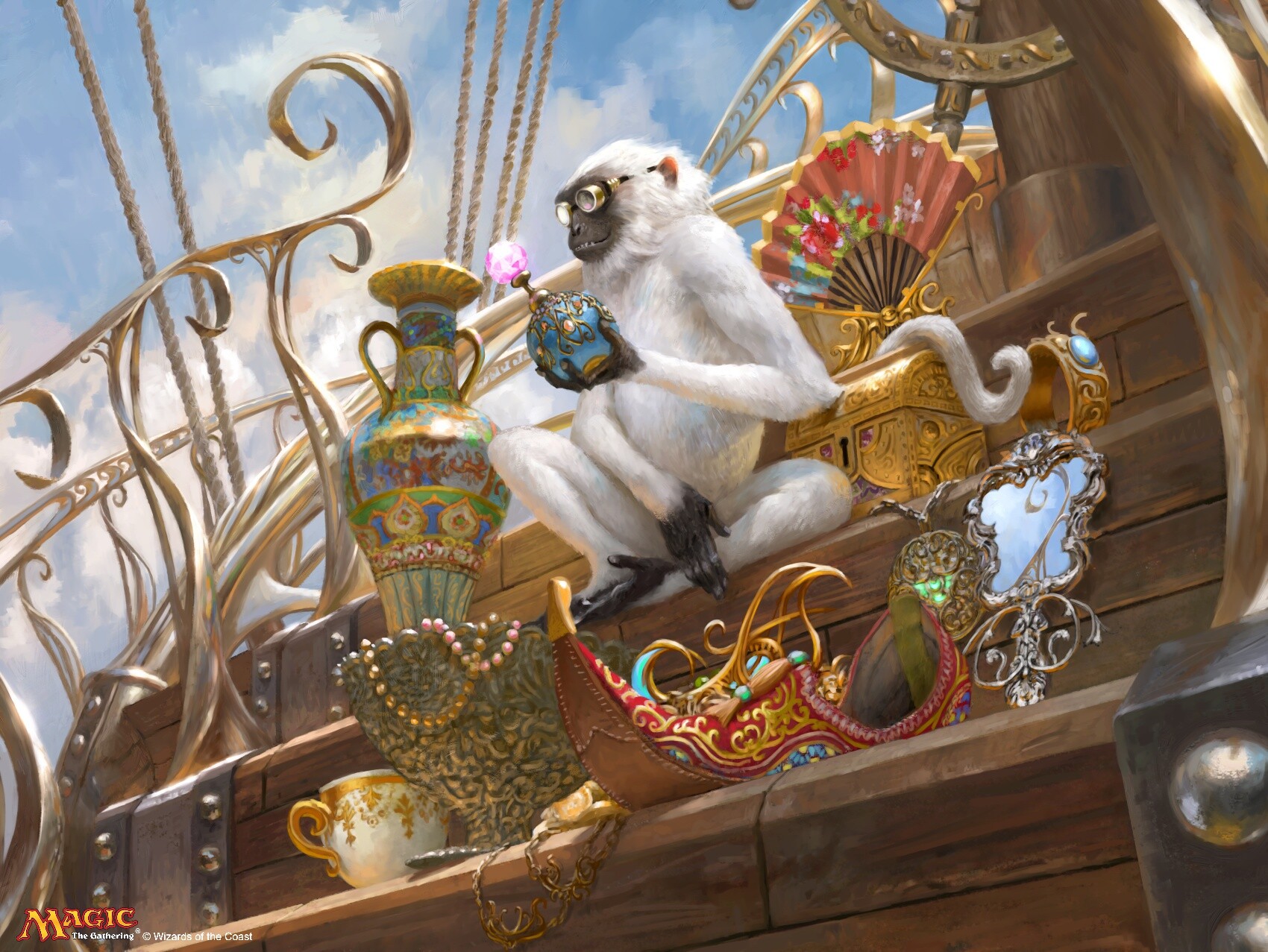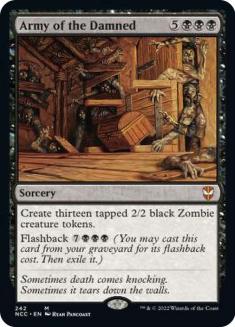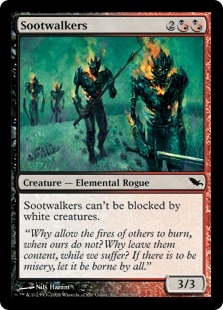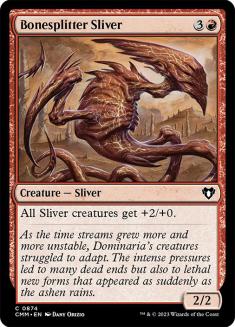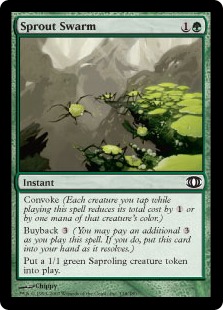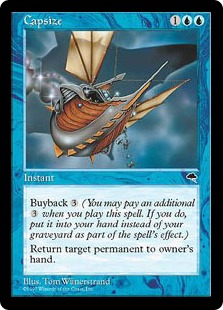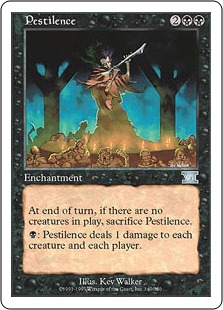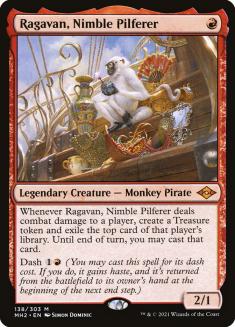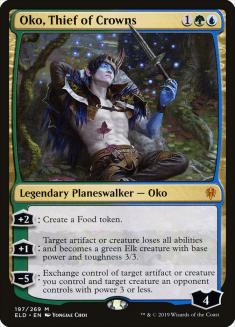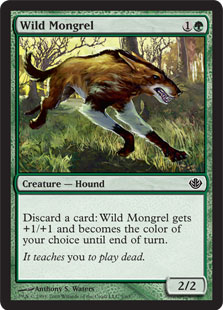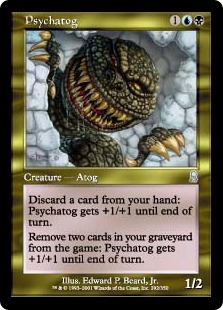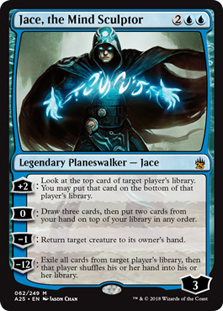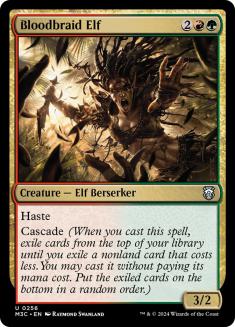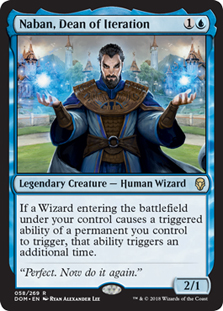I spent a significant portion of my life completely detached from my sense of whimsy, with the beauty of the world evading my gaze as I mostly pondered whether and how things worked. The fact that Magic was a game set in a fantasy world was completely wasted on me. When I started playing, my goals tended to revolve around making the numbers on the cards work in my favor and attempting to prove that I was smart. That I had value. To others, but mostly to myself. When people would talk about the flavor of a card, I honestly had no idea what they could have possibly meant. In some ways, I’m indebted to the card Army of the Damned for waking me from the pale nightmare that my life once was.
Had someone asked me what Shivan Dragon represented in 2010, I’d have balked at the question. I don’t know, it’s an evasive threat that’s priced to move in Limited. It was good in 1993. It was numbers on a page. That’s why Innistrad will always be so special to me. The first time I picked up Army of the Damned, I thought, “Huh. Too many Zombies followed by too many Zombies. That’s exactly what it’s like in the movies. Oh. Ohhhh.”
A friend in college once referred to me as, “The spikiest Spike that ever spiked.” I feel pretty silly looking back at my perspective and attitude from back then, but I simply didn’t understand cards to be the window to other worlds that they are. Magic was a form of escapism for me, but I wasn’t escaping from any fundamental aspects of reality, simply the jobs I didn’t want to do and the people I didn’t want to be around. Okay, maybe I was escaping from some fundamental aspects of reality… but you take my meaning.
I was so wrapped up in Magic as a pursuit to prove something that I didn’t grasp what a powerful tool the game is for expressing and feeling things. This is reflected in my history as a Cube designer, and with age, experience, and perspective, I’d like to walk through some of my history as it pertains to shedding my strictly competitive mindset and how I’ve come to find the joy in engaging with Magic as a means of creative expression. Maybe this will speak to you if you struggle to see the wonder of the world, or if that’s never been a problem for you, then maybe this will help you relate better to people who have walked paths similar to mine. If nothing else, I hope you enjoy the story.
The Saga Begins
I was first introduced to Cube in college, but we played on pretty infrequent occasions, and the idea of actually building a Cube myself never crossed my mind. I simply could not afford such a thing. The Cubes that I did play back then were often in disarray as their owners moved cards in and out of PTQ decks, so Cube Draft was never a consistent option. I understood why this was. Why would you buy a card for a Cube if you already owned a copy for tournament play? It didn’t make financial sense. So say the numbers on the page.
This all changed after I graduated and was introduced to my friend Dana’s Pauper Cube. I had played some Pauper Constructed on Magic Online (MTGO), and Dana’s Cube featured a lot of the heavy-hitters of the common-only format, but it was also teeming with foil commons that he opened from the cases of cards he had bought over the years. The power band read kind of goofy to me, but it was charming. Looking back, I have a lot of appreciation for the Sootwalkers that sometimes made my decks and the Slivers that I wouldn’t draft in a million years.
The big takeaway from that experience was that Pauper Cube was really fun, and it was something that I could afford to build myself. At the time that I built my first Pauper Cube, the expense of sleeving it was actually a pretty significant barrier for me. I begrudgingly bought enough purple Dragon Shields to sleeve a 360 card Cube and basic lands and set out to design my own Pauper environment. I took some inspiration from Dana’s Cube, but my Cube wouldn’t have any “bad” cards. No, I was about Sprout Swarms, not Sootwalkers.
I still keep Sprout Swarm in my Pauper Twobert, but the smaller environment and years of sets, especially Masters and Horizons sets, make it a far more reasonable inclusion than it was in my first Cube. Sprout Swarm wasn’t necessarily the most powerful card in the Cube and I don’t believe it had the highest win rate, but it was the most complained-about card. When people would moan about it, I would explain to them why I thought it was reasonable, but I would later learn a very valuable lesson on this front. Statistics and win rates as feedback aren’t as useful as feelings.
Numbers on a page Ryan, the Ryan who desperately needed to prove something, spent a lot of time telling people that Sprout Swarm wasn’t that bad. What I didn’t hear was that people broadly really don’t care about that sort of thing when it comes to curating a fun experience. There was something upsetting about Sprout Swarm. Something that numbers on a page can’t speak to. That was reason enough to move away from it. I almost never ask players how powerful they think cards are anymore. I’m much more interested in how cards make players feel. If a card is winning too much, there’s a lot you can do to change that. If your friends really hate a card, well, that’s probably just a fact you’re going to have to accept.
This was a lesson that I applied in curating my Tempo Twobert. My original design featured a copy of Ragavan, Nimble Pilferer, which I cut after a few drafts. I think in terms of power level, Ragavan is a fine fit for the format, and is even a pretty disappointing card to draw at times. That said, Ragavan is a card that a lot of players can’t separate in their minds from the games that the card completely ran away with. Nobody remembers Young Wolf bricking Ragavan. Everyone remembers Ragavan stealing their Teferi, Time Raveler.
The numbers on the page were on Ragavan’s side, but there are multiple players in my playgroup who actively dislike the card, and it’s not especially fun for me to field their complaints. I could be obstinate and say they should face the reality of the card’s win rate, but it’s just better for everyone if I face the reality that they’re not going to like the card, and cutting it leads to a more pleasant experience for everyone.
Oko, Thief of Crowns survived in the Cube for approximately one match. I was willing to believe that the average game put a lot of pressure on any three-mana spell, and that might be the case, but the first time I played with a friend, he topdecked Oko on a stalled battlefield and won very easily. I didn’t have fun losing that one, he didn’t have fun winning it, and there wasn’t anything more to discuss.
I’ve similarly pushed back against cards that I considered too weak for some environments. There’s absolutely a line here, but power isn’t the only thing that cards offer. I firmly agreed with the call when Carmen Handy cut Niv-Mizzet Reborn from the MTGO Vintage Cube. Every color has at least one mono-color option that is more powerful, and there are more powerful colorless options, too. That’s not what earns the card a slot, though. Carmen chose to reintroduce the card because people love it. It’s a card that sort of sets its own stipulation for a draft, and that’s fun. More fun and more meaningful than cutting it for whatever 400th most powerful Magic card ever printed you’d want to replace it with.
The Grixis Cube Cometh
The second Cube I ever built was Grixis Cube. It was another exercise in Cubing without bad cards. You know, the green and white ones. This Cube was ultimately featured as a Spotlight Cube on MTGO and was convincingly a successful design. When I pitched the Cube for MTGO, I felt the reservation in my gut about green and white being some players’ favorite colors. My brain told me these colors were expendable in high-power environments, but on some level I understood that my approach was subtractive and dismissive.
My goals for Grixis Cube were pretty explicitly about technical design, and I didn’t immediately appreciate the other color-restricted Cubes that followed it in the Spotlight series. Autumn Burchett’s Bant Cube, Ellie Rice’s Temur Cube, and David McDarby’s Mardu Cube all excluded one of the “good” colors. What gives? Well, they were all building something cool from the ground up. Something that purely analytical Ryan could never fully understand or appreciate.
All of these designs were more creative than mine. They’re all explorations of things that these players enjoy, and they were much more explorations of the three colors featured than rejections of the colors excluded. If I were to get another crack at running the Grixis Cube on MTGO, I would draw a lot of inspiration from these three designs and things would look pretty radically different.
My original Grixis Cube design mostly only asked which cards could compete with the most powerful cards ever printed. I took this being fun as a given. The powers that be had reservations about my pitch regarding whether a color-restricted Cube could support enough archetypes to be engaging. The fact that playtests at Wizards of the Coast (WotC) determined that it did was completely accidental on my part.
I’m glad that Grixis Cube walked in this way so that these other Cubes could run. A redesign would be a whimsical celebration of all the different fun and sweet things that you can do with red, black, and blue cards, rather than a rejection of anything you can do with green and white ones.
My Faux Magnum Opus
My third Cube was one that I considered my greatest creation for many years. I truly believed I would never be able to build anything better than my Spooky Cube. The aesthetic was awesome, the decks were unique, and people talked about it when we weren’t playing it. It was more than just a Cube. I thought that Spooky Cube’s overlapping synergies and flexible draft lanes could really change the way that people thought about Cube design. What I ignored for a long time was that it was very common for players to draft horrible decks the first time they played the Cube.
My technical approach to Spooky Cube was to keep the power band really narrow. I liked the idea of being able to draft most any card out of most any pack. I hold that there’s a real argument for Anger and Wonder being the most powerful cards in the Cube, but a friend of mine likes to rave about how first-pickable Lava Coil is. In that way, I’ve been successful in this design. That said, a narrow power band like this can really invite decision paralysis to players experiencing the Cube for the first time. I would tell myself that’s spooky, that works, but it is an aspect of the Cube that greatly reduces its accessibility.
Niv-Mizzet Reborn is cool because it tells you how to draft, and power level outliers like the Sublime Epiphany that we often see in Arena Cubes hold your hand and tell you that you’ll be okay as long as you can play blue. Some of this comfort goes a long way. More than once while drafting Spooky Cube, one player just drafted a bunch of lands while waiting for a spell that would pull them to a specific color that never came. Their decks were completely incoherent and could barely buy a game despite their perfect mana. My narrow power band “feature” was in reality a very serious bug.
Spooky Cube was modeled heavily after Innistrad, and also borrows quite a lot from Odyssey block. I have a fondness for that era because cards from those sets were relatively new when I started playing and were abundant and affordable. Decks from that time seem really simple to me by today’s standards, and there’s something really charming about that era.
I was listening to old episodes of Mark Rosewater’s Drive to Work podcast recently, and his episodes on Odyssey were really illuminating. The long and short of it is that Odyssey was a tremendously Spikey block. Less competitive players don’t have the same appreciation for Wild Mongrel that I do. If all you care about is numbers on a page, then discarding a card for some effect is inviting, but if you like all your cards and you want to play with them, you really don’t want to be discarding them instead!
There wasn’t anything inherently wrong with my vision for a narrow power band, but with so many of the cards being Wild Mongrel-adjacent, my idea for a Cube where you could realistically draft any card from any pack left gaps where many players wouldn’t be able to find the fun. I had unknowingly concocted one of the Spikiest Cubes that ever spiked.
When I redesigned the Cube to convert it to a modular Twobert design, I reintroduced a handful of power level outliers and would make the draft more approachable for first-time drafters. More than that, I am now armed with the knowledge that Spooky Cube is by its nature an environment with a steep learning curve. I still love Spooky Cube, but it does have significant barriers to entry. Acknowledging that was important in my development.
The Twobert Renaissance
When I started working on my original Twobert model, I had no idea what I had. My friends immediately fell in love with it, and friends of friends were hooked after one play. When I first pulled out the box to play, it was just a thing that we could try. Perhaps I was too humble. I can truthfully say that I didn’t understand at the time that the ideas that made my 180-card designs successful were directly inspired by the lessons I was slowly learning from Spooky Cube.
Most of the design was centered around only including cards that you could realistically play in one style of deck, but the Cube was also a more accessible implementation of my vision for a Cube with a narrow power band. Beyond that, my insistence on finding cards that were exciting without including anything groan-inducing was absolutely informed by my experience with Sprout Swarm. I remember thinking about Jace, the Mind Sculptor a lot when I was working on this design. It has a wow factor, but it’s also one that has been held in check in multiple formats to the point that the window where it was a totally dominant force was short and long enough ago that few players hold a grudge.
Bloodbraid Elf was the original “hero” that held Jace in check. If I could just fill the Cube with creatures advantaged against Jace’s -1 ability, then I would be golden. This worked out much better than even I thought when we started playing games. Not only was Jace not dominant – a real risk in singleton Magic – the card still carried its cool mythos, even while any and every creature won games against it. Jace is fully capable of crossing the Oko line for inducing groans if you’re not careful, and many cards depend on your Cube’s power level, but as long as a card isn’t deflating just by its mere existence, there are ways to make the card fun.
Even with a narrow power band and balanced gameplay, you sometimes do just lose to the most powerful cards in the Cube. This can be Jace, and is more commonly a six-drop. And that’s not only fine, but is actively good. An experienced player can get into the crunchy evaluation of whether they should try to draft a leaner deck or go big with a Grave Titan while drafting, and one that finds that evaluation stressful or unapproachable can just take the Grave Titan and be relatively confident that it will be a high-impact card. The fact that the more skilled player doesn’t win every time is ultimately one of Magic’s most positive attributes.
The original Twobert was truly a Cube where you could draft basically whatever you wanted from any pack and make it work. Unlike Spooky Cube, this applied all the way down to mana-fixing lands. The design was less “for me” than some of my others, but it was far more “for anyone.” It is without a doubt my finest work to date.
Asking How, Not If
I would like to close today with one of the most important shifts in perspective I’ve ever made as a Cube designer. It is very common in conversation to see people refer to some cards or strategies as “not good enough for Cube.” This is the joyless black-and-white thinking that held me back for years. Cube isn’t any one thing, and there’s a way to make whatever you want to make. Power level is a thing, but it’s by no means the only thing. I no longer ask myself if something can work in Cube, but how something can work in Cube. I don’t always have an answer, but it’s a more interesting question. A more creative one.
Meaning and value are subjective. Experience is subjective. Even numbers on a page are subject to interpretation. I once believed that a great Cube was one where every card was playable, and that playable meant powerful. In a way I was right, because as I understand it now, a great Cube is an honest expression of its designer’s interests. There are better and worse ways to approach things if your goal is to offer a replayable and fun experience to other players, but as long as you’re designing something in earnest, your Cube will be great.
Pursue whatever you think is cool. If you like it, you can Cube it. The rest of the stuff – balance, replayability, archetypes – that can all be iterated. And maybe the only thing you do care about is which cards are powerful. That’s fine, too. I know exactly how you feel. Whatever you want to express, whatever you want to create, there’s a way to make it happen.
You may not love your first Cube, or even not like your first Cube. You could have difficulties with card evaluations or with understanding flavor and aesthetics to work through before things start to click. It might take years to really figure out who you are and what you want. But it’s a question worth asking. I’m confident that you’ll figure it out.

